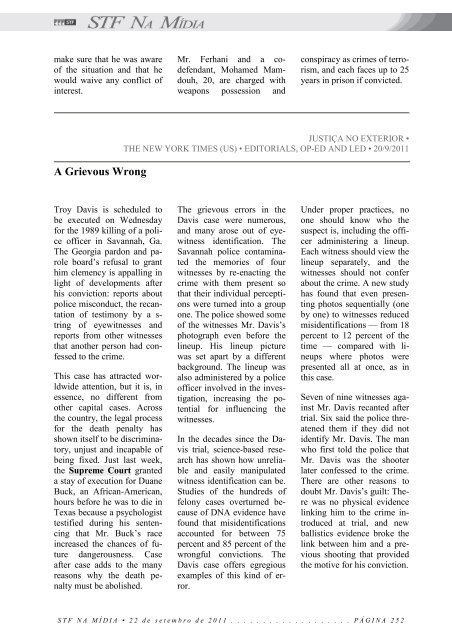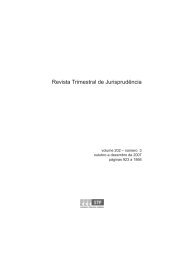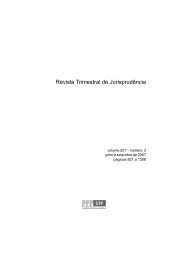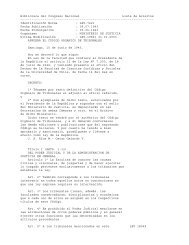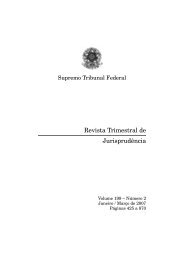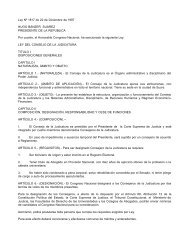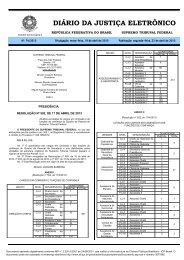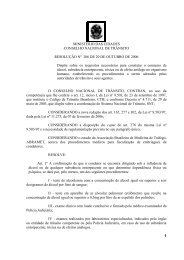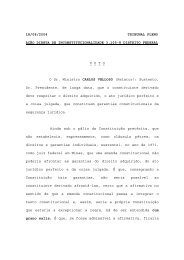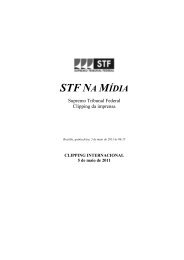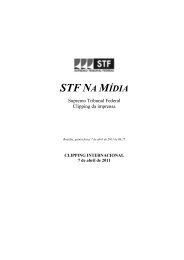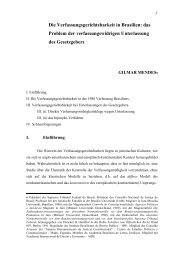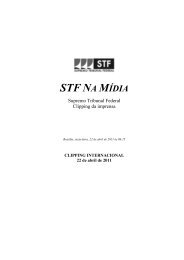STF NA MÍDIA
STF NA MÍDIA
STF NA MÍDIA
Create successful ePaper yourself
Turn your PDF publications into a flip-book with our unique Google optimized e-Paper software.
make sure that he was aware<br />
of the situation and that he<br />
would waive any conflict of<br />
interest.<br />
Mr. Ferhani and a codefendant,<br />
Mohamed Mamdouh,<br />
20, are charged with<br />
weapons possession and<br />
conspiracy as crimes of terrorism,<br />
and each faces up to 25<br />
years in prison if convicted.<br />
A Grievous Wrong<br />
JUSTIÇA NO EXTERIOR •<br />
THE NEW YORK TIMES (US) • EDITORIALS, OP-ED AND LED • 20/9/2011<br />
Troy Davis is scheduled to<br />
be executed on Wednesday<br />
for the 1989 killing of a police<br />
officer in Savannah, Ga.<br />
The Georgia pardon and parole<br />
board’s refusal to grant<br />
him clemency is appalling in<br />
light of developments after<br />
his conviction: reports about<br />
police misconduct, the recantation<br />
of testimony by a s-<br />
tring of eyewitnesses and<br />
reports from other witnesses<br />
that another person had confessed<br />
to the crime.<br />
This case has attracted worldwide<br />
attention, but it is, in<br />
essence, no different from<br />
other capital cases. Across<br />
the country, the legal process<br />
for the death penalty has<br />
shown itself to be discriminatory,<br />
unjust and incapable of<br />
being fixed. Just last week,<br />
the Supreme Court granted<br />
a stay of execution for Duane<br />
Buck, an African-American,<br />
hours before he was to die in<br />
Texas because a psychologist<br />
testified during his sentencing<br />
that Mr. Buck’s race<br />
increased the chances of future<br />
dangerousness. Case<br />
after case adds to the many<br />
reasons why the death penalty<br />
must be abolished.<br />
The grievous errors in the<br />
Davis case were numerous,<br />
and many arose out of eyewitness<br />
identification. The<br />
Savannah police contaminated<br />
the memories of four<br />
witnesses by re-enacting the<br />
crime with them present so<br />
that their individual perceptions<br />
were turned into a group<br />
one. The police showed some<br />
of the witnesses Mr. Davis’s<br />
photograph even before the<br />
lineup. His lineup picture<br />
was set apart by a different<br />
background. The lineup was<br />
also administered by a police<br />
officer involved in the investigation,<br />
increasing the potential<br />
for influencing the<br />
witnesses.<br />
In the decades since the Davis<br />
trial, science-based research<br />
has shown how unreliable<br />
and easily manipulated<br />
witness identification can be.<br />
Studies of the hundreds of<br />
felony cases overturned because<br />
of D<strong>NA</strong> evidence have<br />
found that misidentifications<br />
accounted for between 75<br />
percent and 85 percent of the<br />
wrongful convictions. The<br />
Davis case offers egregious<br />
examples of this kind of error.<br />
Under proper practices, no<br />
one should know who the<br />
suspect is, including the officer<br />
administering a lineup.<br />
Each witness should view the<br />
lineup separately, and the<br />
witnesses should not confer<br />
about the crime. A new study<br />
has found that even presenting<br />
photos sequentially (one<br />
by one) to witnesses reduced<br />
misidentifications — from 18<br />
percent to 12 percent of the<br />
time — compared with lineups<br />
where photos were<br />
presented all at once, as in<br />
this case.<br />
Seven of nine witnesses against<br />
Mr. Davis recanted after<br />
trial. Six said the police threatened<br />
them if they did not<br />
identify Mr. Davis. The man<br />
who first told the police that<br />
Mr. Davis was the shooter<br />
later confessed to the crime.<br />
There are other reasons to<br />
doubt Mr. Davis’s guilt: There<br />
was no physical evidence<br />
linking him to the crime introduced<br />
at trial, and new<br />
ballistics evidence broke the<br />
link between him and a previous<br />
shooting that provided<br />
the motive for his conviction.<br />
S T F N A M Í D I A • 2 2 d e s e t e m b r o d e 2 0 1 1 . . . . . . . . . . . . . . . . . . . P Á G I N A 2 5 2


